87.5% screwed
Hi friends!
This month, we’ll explore the safe and just space for humans on Earth; how to turn a gnawing rat of avoidance into a fluffy white sheep of possibility; and democratic principles for doing the work to build the world we want.
Facts: We’re 87.5% screwedWe’re in trouble: humanity has crossed seven out of eight global thresholds needed to keep Earth stable and provide a good life for all, according to the Earth Commission report. Eeek!
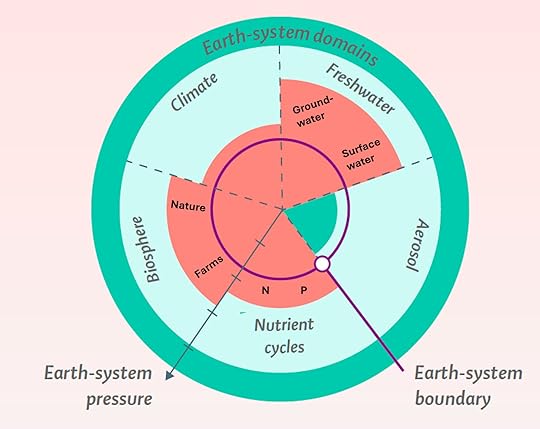 Current status of eight Safe and Just Earth System Boundaries, where seven of eight are in the red danger zone. Source:
Lancet infographic
based on Gupta et al., 2024. I added the boundary names in bold (e.g, N, P).
Current status of eight Safe and Just Earth System Boundaries, where seven of eight are in the red danger zone. Source:
Lancet infographic
based on Gupta et al., 2024. I added the boundary names in bold (e.g, N, P). Climate, groundwater depletion, surface water overuse, nitrogen and phosphorous pollution, land for nature, and natural vegetation within human-dominated landscapes are all in the danger zone. Only particulate air pollution (aerosols) hasn’t crossed global limits, though it’s over the line in some regions.
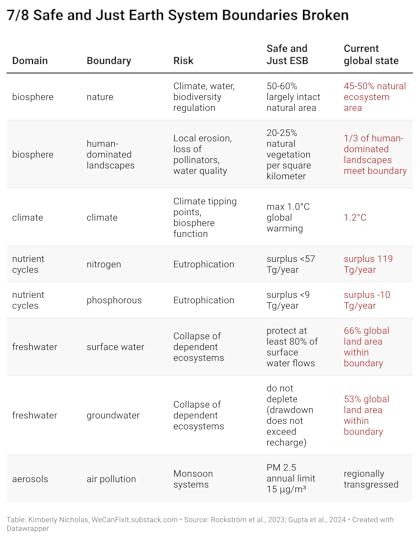 The eight Earth System Boundaries, the risks from breaking them, the safe and just boundary threshold, and the current global state. Boundaries over the limit are shown in red. Source: My own visualization from data in Rockström et al., 2023 and Gupta et al., 2024
The eight Earth System Boundaries, the risks from breaking them, the safe and just boundary threshold, and the current global state. Boundaries over the limit are shown in red. Source: My own visualization from data in Rockström et al., 2023 and Gupta et al., 2024This study builds on work dating back 15 years, including the inspiration for this gem:
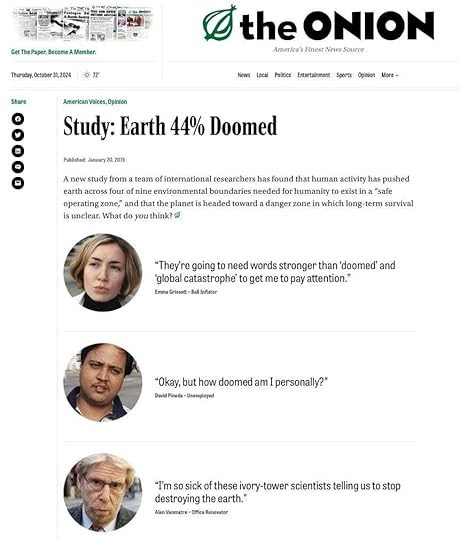 Possibly my favorite piece from The Onion, in response to the 2015 Planetary Boundaries study. Needs above the floor, pressure below the ceiling
Possibly my favorite piece from The Onion, in response to the 2015 Planetary Boundaries study. Needs above the floor, pressure below the ceiling Scientists created these “safe and just Earth System boundaries” by combining the planet’s biophysical limits (the ceiling) with meeting everyone’s basic needs (the floor).
The goal is the green zone, where all people have access to minimum needs for food, water, energy, and infrastructure, without putting too much pressure on Earth systems.
The just zone means sharing resources fairly among species (who all need a stable planet), across generations, and among today’s communities.
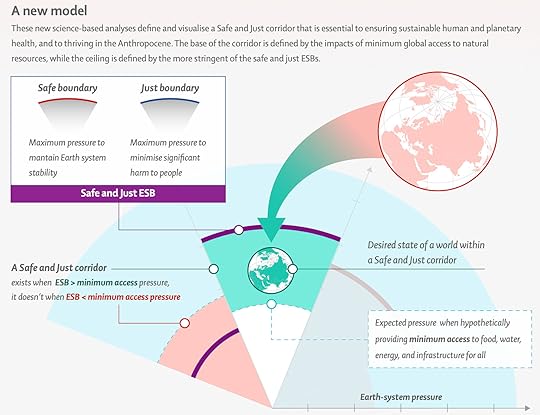 Safe and Just Earth System Boundaries are met when all people have basic needs met, within a stable Earth system. Source: Lancet infographic based on Gupta et al., 2024. Solutions: Reduce and redistribute; align the economy with justice; expand sustainable tech
Safe and Just Earth System Boundaries are met when all people have basic needs met, within a stable Earth system. Source: Lancet infographic based on Gupta et al., 2024. Solutions: Reduce and redistribute; align the economy with justice; expand sustainable tech To get to the safe and just space, the Earth Commission suggests three main solutions:
Reduce and reallocate consumption: cut waste and set limits on harmful overuse, while ensuring everyone has what they need.
Transform the economy: Align markets with sustainability and justice by factoring in environmental costs, and stopping harmful subsidies and investments.
Expand sustainable tech: Make efficient, affordable tech available worldwide to create a circular, low-impact economy.
P.S. I’m working on solutions that will get us to the Safe and Just space- stay tuned!
Feelings: “Befriend your gnawing rats”You know the things you’re avoiding because they make you anxious to think about? Like the cluttered garage you never get around to cleaning… or the nagging health concern you keep putting off… or, you know, taking meaningful climate action??
The wise-but-not-treacly Oliver Burkeman, in Meditations for Mortals, has great advice for facing these stressors, borrowing a vivid metaphor from Paul Loomans, who calls them “gnawing rats.”
Instead of the usual advice to attack the problem head-on, or break tasks into smaller parts, Burkeman advises to start by accepting the rats’ existence.
It’s a gentler approach based on accepting reality as it already is, and turning towards the gnawing rats:
Some ways to befriend your gnawing rats, thanks to Burkeman:
“[T]o befriend a rat is to defuse the anxiety you feel by transforming the kind of relationship you have with it… You turn it into an unobjectionable part of your reality. Whereupon a gnawing rat, in Looman’s terminology, becomes a ‘white sheep’— a harmless, docile, fluffy creature that follows you around until you decide to do something about it.”
—Oliver Burkeman, Meditations for Mortals
Take the easiest step forward: Find the least intimidating way to begin.
Ask for help: Your gnawing rats may be someone else’s harmless white sheep- and they likely have some of their own rats you could help them with.
Visualize getting started: Close your eyes and picture yourself taking action.
“Just go to the shed”: Visit the space that’s making you anxious and guilty, have a look around, and let the first solutions reveal themselves.
Do something you can actually do today: If an hour of work sounds overwhelming, could you tolerate half an hour? 15 minutes? 10?? (At my low point in writing my dissertation, I had to start with 10-minute writing sessions. It did eventually get written. I also like to set a 5 minute timer to start a task I don’t wanna do; usually I have enough momentum to continue from there once I’ve started.)
What small step could you take today to start befriending one of your gnawing rats?
P.S. Remember the 5 Stages of Climate Feelings— avoidance is #2, and the way from Doom to Purpose is via All the Feels!
Action: How to Organize DemocraticallyThere’s a lot of important and urgent work to do. How do we work well within teams and communities to make lasting progress?
Thankfully, nearly 30 years ago, environmental justice leaders developed the Jemez Principles for Democratic Organizing, which can help us organize in a fair, inclusive, and effective way. Here’s a brief summary:
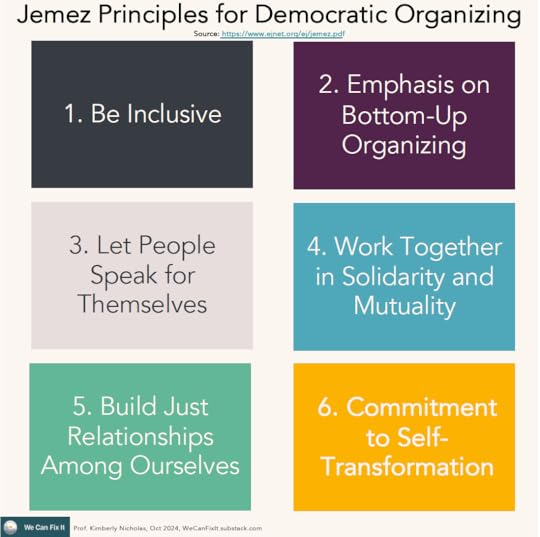 The Jemez Principles of Democratic Organizing. Source: https://www.ejnet.org/ej/jemez.pdf Jemez Principles for Democratic Organizing
The Jemez Principles of Democratic Organizing. Source: https://www.ejnet.org/ej/jemez.pdf Jemez Principles for Democratic Organizing (This is a selected summary; full text here.)
1. Be inclusive.Build inclusion into your movement, going beyond tokenism to include diversity throughout planning and action. It might take more time and effort, but it’s essential.
2. Emphasis on Bottom-Up OrganizingReach out to new groups, and strengthen your existing base. Building a strong grassroots foundation gives your movement credibility, strategy, and “the energy for the work we must do daily.”
3. Let People Speak for Themselves“We must be sure that relevant voices of people directly affected are heard.” Community spokespeople should be genuine representatives. Assure accountability.
4. Work Together in Solidarity and MutualityCollaborate with groups whose visions align with yours, and support each others’ work. Ultimately, integrate their goals and values in your own work. For example, a labor union including environmental goals in their own strategies, rather than just supporting environmental organizations.
5. Build Just Relationships Among OurselvesTreat everyone with respect and fairness, within and across organizations. This includes being transparent about decisions, sharing resources, and ensuring equitable strategies.
6. Commitment to Self-Transformation“We must ‘walk our talk.’ We must be the values that we say we’re struggling for.”
What parts of your work could benefit from these principles? Have you found other effective ays to run fair and inclusive processes? I’d love to hear your thoughts- feel free to share n the comments below, or by reply to this email!
Thanks for reading! Please share this post with a friend to spread climate action.
Parting Tidbits Upcoming talks, come see me here:Extreme Wealth and Climate Inequality: If you’re in Lund, join us on November 20th at 18:00 for a lecture from philosophy professor Ingrid Robeyns and discussion panel on her new book “Limitarianism: The Case Against Extreme Wealth.”
Recent podcast:I discussed what the US election means for global climate, and answer listener questions about China’s emissions and 1.5°C. Listen from 18:00-27:30:
Book Recommendation:American Mermaid, by Julia Langbein. A wild and surreal novel about staying sane and principled in a world that increasingly isn’t. Felt pitch-perfect for this moment. I want to live in a world where fierce mermaids take on evil technocrats destroying the climate!
Thanks for reading. Take care, friends!
xo,
Kim
This post is free to make climate action accessible to everyone. Please subscribe to receive new posts. If you find my work valuable and are financially able, I am grateful for any support you can give as a paid subscriber.



